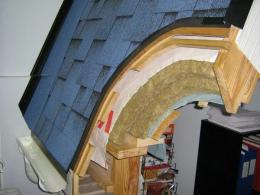Search
Login
Do-it-yourself vapor barrier of the attic roof
Increasing the living space of our home, we go under the roof, i.e. we create a living room in the form of an attic. To live comfortably in this room, it is necessary to create a mansard roof pie, and it is possible to protect this pie by laying a vapor barrier.
Content
- General information video
- Roofing video
- Ensuring the air tightness of the waterproofing layer
- Fixing the film to the eaves overhang
- Film fastening in the area of \u200b\u200bthe roof ridge
- Fixing the film in the valley of the valley
- The main moments of the installation of hydro-wind protection
General information
In order to remove the possibility of moisture penetrating from the outside to the attic insulation - the insulation is covered with a waterproofing on top. In this article, we will consider the basic rules for laying a vapor barrier of a roof and talk about certain difficulties that may arise during, at first glance, such a simple job. Currently, diffusion films or membranes are widely used, they are popularly called vapor-permeable, they are made of polyethylene or polypropylene. The fact is that condensate forms on the back of some roofing materials, it accumulates and enters the attic insulation, vapor-permeable films prevent the penetration of moisture into the insulation, and in addition, they perform another important task - they prevent the release of warm air from the insulation, t. e. serve as wind protection and are an airtight layer.
Thus, a thin film in appearance plays an important role in protecting the building, and the cost of heating it is reduced. Using such a film, we can arrange a roofing cake and protect it to further maintain the heat of the building, otherwise, when wet, the insulation loses its properties.
Using vapor-tight films, ventilation gaps are created - one between the film and the insulation, and the second between the film and the roofing material. But vapor-permeable films (hydro-wind-proof layer) or diffusion membranes do not require the creation of two ventilation gaps, these membranes are simply laid on top of the insulation, that's why the use of vapor-permeable membranes is very important when installing roofs of complex geometry.
Roofing
Installation of vapor barrier of a roof or diffusion film is very easy to do with your own hands, but you must follow the installation instructions.
The vapor barrier is laid from the lower edge of the ramp, along the eaves, and then the next layer is overlapped and thus moves in the direction of the ridge. The waterproofing is laid with an interference fit, as it is laid, it is fixed on the rafter legs with the help of a stapler, but you can use nails with a wide hat, then the film is attached with bars to the counter-lattice (they are nailed to the rafters), it is the counter-lattice that provides a ventilation gap between the film and the roof.
The installation of vapor barrier, as already mentioned, occurs with overlapping paintings. The overlap directly depends on the slope of the roof and on the roofing material. If the slope is standard, an overlap of 100 mm. (for each roofing material, its own standard slope), if the slope is small - overlap is made up to 200 mm. For greater reliability, the joints of the sheets need to be glued with special tapes or glue.
Ensuring the air tightness of the waterproofing layer
Professionals advise, if the roof slopes are standard, it is necessary to seal the overlays of the paintings with special one - or double-sided tapes, or glue.
Using this method, they achieve airtightness of the insulating layer and significantly improve the energy-saving properties of the hydro-windproof layer. Particular attention must be paid to the joints of the counter-battens and vapor barrier, these places are sealed with tapes or pastes. All these efforts are aimed at ensuring that external moisture does not penetrate through the mounting holes.
Fixing the film to the eaves overhang
The beginning of the film fastening is on the eaves overhang, but the whole point is that the film needs to be fixed so that air freely enters the ventilation gap. The best way is to glue the bottom edge of the film to the ledge of the cornice, this strip is below the fastening of the gutter. And the gutter itself is attached to the extreme board in the plane of the crate.
Film fastening in the area of \u200b\u200bthe roof ridge
In the case of installation of insulation to the ridge - the vapor barrier film is laid with overlap over the ridge. But sometimes thermal insulation, in order to save money, is not brought to the ridge, but is laid only in the plane of the future room, additionally insulating the ceiling of this room. Thus, a small attic is obtained at the top.
But the vapor barrier film, it is better to put it with an overlap over the ridge, but before installing the ridge, ventilation holes are cut in the film, specifically under the ridge, up to 10 cm in size. The ventilation holes in the vapor barrier film can not be cut if, to ventilate this small attic, on the gables of the building, ventilation grilles are mounted.
Fixing the film in the valley of the valley
At the junction of the two roof planes, the installation of the valley is carried out. These are the most dangerous sections of the roof, difficult to install, since it is necessary to exclude leaks and therefore a reliable waterproofing layer is required under them. Many companies, in their recommendations, advise laying vapor barrier in three layers. It is advised to lay with the overlap of one slope on the other, and on top, with an even distribution on both slopes, they suggest laying the third layer of the film. This method requires a large consumption of vapor barrier films, the installation itself leads to horizontal joints, these joints must be glued.
The second method, which, according to experts, is preferable - rolling the film roll along the axis of the valley, in a continuous layer, this will eliminate the formation of transverse joints. But the correct vapor barrier must be a high-quality diffuse membrane, have high tensile strength and this film must be laid under the counter-grill. The counter grill is able to press the film in the valley.
The main moments of the installation of hydro-wind protection
The main points when installing a vapor barrier (waterproofing layer) are to ensure tightness of the junction of the film to all roofing passage elements, such as: antennas, fireplaces, stove or ventilation pipes, attic windows, etc.
Depending on the type of surface, a sealant is also selected, namely: smooth surfaces are glued with one or two-sided tapes, it is possible to glue with synthetic rubber glue;
non-smooth surfaces, the film is attached to them with one-sided butyl rubber tapes, up to 100 mm wide., or with synthetic rubber glue.





